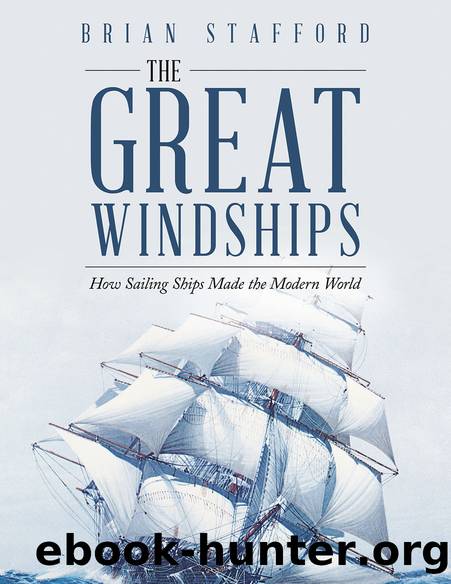The Great Windships: How Sailing Ships Made the Modern World by Brian Stafford

Author:Brian Stafford [Stafford, Brian]
Language: eng
Format: epub
ISBN: 9781669888154
Google: nZGJEAAAQBAJ
Publisher: Xlibris Corporation
Published: 2022-09-12T21:00:00+00:00
The Role of Cotton
Cotton cultivation dates back 8,000 years in America and at least 7,000 years in Asia and was a common fabric in Europe in the Middle Ages. Its manufacture was introduced into the Mediterranean with the Muslim conquest. Columbus found Indians wearing cotton cloth in the West Indies, feeding his conviction that he had reached the Orient.
Cotton working was the largest manufacturing industry in the Mughal Empire and was responsible for a large part of its international trade. India had an estimated 25 per cent of the world market in the early eighteenth century. Renaissance and, later, Enlightenment Europe was dependent on imports from Mughal India. Indians were skilled spinners and weavers, and their light cotton fabrics, when introduced into England by the East India Company, were a hit. However, it was the cheapest cotton fabric, calico, that proved extremely popular among the poor, damaging demand for local woollen fabrics and causing its importation to be banned in 1721: a ban that was not lifted until 1774.
Great Britainâs inventive genius had by then produced machines such as the âspinning jennyâ and the water frame. These devices permitted cotton goods to be woven quickly and in considerable volume, enabling Britain to compete with imports from India. Later in the eighteenth century, cotton goods made up 16 per cent of the countryâs exports. By the early nineteenth century, that proportion had risen to 42 per cent, and Britain was dominating the world market. India was forbidden to export to Great Britain, and its population forced to accept inferior British goods. Once Britain could source raw cotton from America, the British East India Company discouraged the production of cotton in India by forcing its growers to produce opium.
The rapid development of British cotton manufacture was only made possible by the equally rapid increase in the production of the cotton staple, Gossypium, of which there are several varieties. Cultivation is, however, very labour-intensive, and keeping up with demand required an ever-increasing supply of African slaves.
In 1791, cotton production in the Southern states of the United States was 900 tons. The application of steam power to cotton manufacture in England increased demand for the staple dramatically. In 1789, as cheap sources of coal became available, steam engines were applied directly to driving cotton mills.
In 1793, Eli Whitney, an American inventor, came up with a mechanical âginâ that substantially reduced the time taken to remove the seed from the cotton boll. By 1800, exports had reached 56,000 tons, over sixty times what total production had been just nine years earlier. By the middle of the century, production was 441,000 tons, of which 414,000 tons, or 94 per cent, was exported.
Download
This site does not store any files on its server. We only index and link to content provided by other sites. Please contact the content providers to delete copyright contents if any and email us, we'll remove relevant links or contents immediately.
| Africa | Americas |
| Arctic & Antarctica | Asia |
| Australia & Oceania | Europe |
| Middle East | Russia |
| United States | World |
| Ancient Civilizations | Military |
| Historical Study & Educational Resources |
Machine Learning at Scale with H2O by Gregory Keys | David Whiting(4179)
Never by Ken Follett(3790)
Fairy Tale by Stephen King(3220)
The Man Who Died Twice by Richard Osman(2997)
Oathbringer (The Stormlight Archive, Book 3) by Brandon Sanderson(2881)
Will by Will Smith(2793)
Rationality by Steven Pinker(2291)
The Dark Hours by Michael Connelly(2243)
Can't Hurt Me: Master Your Mind and Defy the Odds - Clean Edition by David Goggins(2227)
The Dawn of Everything: A New History of Humanity by David Graeber & David Wengrow(2122)
Friends, Lovers, and the Big Terrible Thing by Matthew Perry(2119)
Principles for Dealing With the Changing World Order: Why Nations Succeed and Fail by Ray Dalio(1974)
HBR's 10 Must Reads 2022 by Harvard Business Review(1777)
A Short History of War by Jeremy Black(1762)
Go Tell the Bees That I Am Gone by Diana Gabaldon(1687)
515945210 by Unknown(1599)
A Game of Thrones (The Illustrated Edition) by George R. R. Martin(1589)
Kingdom of Ash by Maas Sarah J(1524)
443319537 by Unknown(1470)
